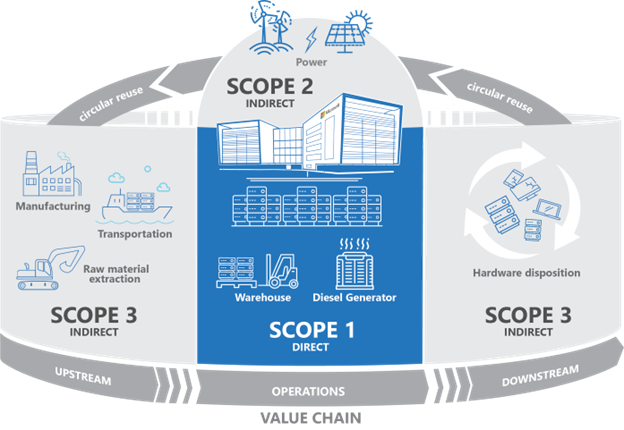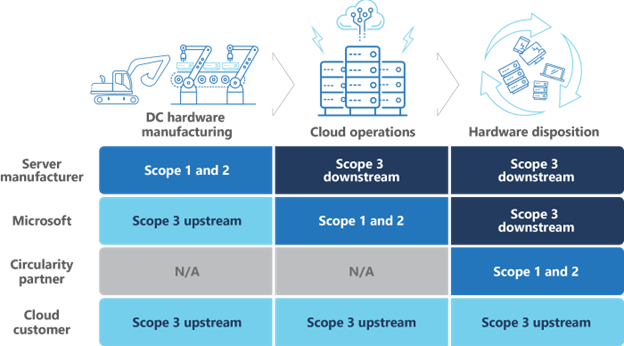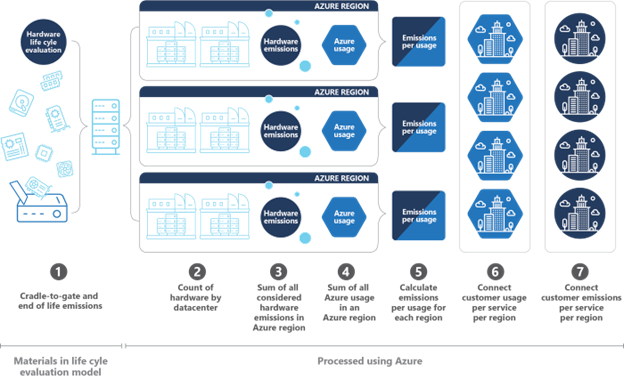Microsoft Cloud for Sustainability API calculation methodology
Important
Some or all of this functionality is available as part of a preview release. The content and the functionality are subject to change.
Microsoft's cloud carbon calculation methodology calculates the carbon emissions associated with the use of Microsoft’s Azure and Microsoft 365 cloud computing resources. It covers scope 1, 2, and 3 carbon emissions as calculated from the manufacture, packaging, transportation, use, and end-of-life phases of data center hardware in all data centers owned and leased by Microsoft. The emissions and usage measured by this methodology are for Microsoft’s Azure and Microsoft 365 cloud only. The Microsoft 365 methodology is limited to emissions associated with using the following products:
- Microsoft Exchange Online
- Microsoft SharePoint
- Microsoft OneDrive
- Microsoft Teams
- Microsoft Word
- Microsoft Excel
- Microsoft PowerPoint
- Microsoft Outlook
Note
Carbon accounting practices are evolving rapidly. We're committed to evolving, revising, and refining our methodologies over time to incorporate science-based, validated approaches as they become available and relevant to assessing the carbon emissions associated with the Azure cloud.
Important
In February 2024, your data will undergo recalculation due to an update in the methodology that now allows for a more detailed attribution of carbon emissions. For more information about these changes, go to Calculations update FAQ.
The following image shows examples of scope 1, 2, and 3 carbon emission types in the Microsoft cloud value chain.

Standards used for calculation
At Microsoft, we segment our greenhouse gas (GHG) emissions into three categories consistent with the Greenhouse Gas Protocol, which is a globally recognized standard for the calculation methodology and reporting of Greenhouse Gas (GHG) emissions:
Scope 1: Direct emissions – Emissions from stationary and mobile combustion, as well as process and fugitive emissions.
Scope 2: Indirect emissions - Emissions from the consumption of electricity, heat, or steam.
Scope 3: Other indirect emissions – Manufacturing phase and end-of-life emissions (supply chain related). The scope of this tool is scope 3 categories 1, 2, 4, 5, 9, and 12.
The API calculations are the result of a life cycle evaluation. This evaluation assessed energy use for cloud computing operations and carbon emissions related to the following activities for Azure and Microsoft 365:
- Manufacturing phase raw materials extraction
- Component aggregation
- End of management of materials
The following image shows carbon accounting scopes by stakeholder:

Included emission sources
GHG emissions are classified into scope 1, 2, and 3 emissions based on the level of control that an organization has over the sources of those emissions.
Scope 1
GHG emissions include emissions from the combustion of diesel fuel and fugitive emissions from the use of refrigerants for cooling of our data centers. Our scope 1 emissions are small compared to our scope 2 emissions, so we combine them for reporting purposes.
Scope 2
GHG emissions include emissions from direct power consumption used to power global data centers that Microsoft leases and owns. We invest in renewable energy power purchase agreements (PPAs) globally. We plan to be powered by 100% renewable energy and eliminate fossil fuels from backup power by 2025.
Scope 3
GHG emissions include emissions from the following activities for hardware devices. The devices include servers and network equipment used in our leased and owned data centers.
- Raw material extraction
- Select component aggregation
- End-of-life management (for example, recycling, landfill, or composting)
This tool includes the emissions from the raw material extraction of the different parts and components that make up the hardware devices and their packaging. It uses material composition and emissions resulting from product life cycle stages.
By their nature, scope 1, 2, and 3 emissions are all relative to the reporting entity; one company’s scope 1 emissions are another’s scope 3 emissions. This tool reflects Microsoft’s combined scope 1, 2, and 3 emissions associated with the delivery of Azure and Microsoft 365 core cloud services. These emissions reflect a customer’s scope 3 emissions from the customer’s use of Microsoft cloud services.
Calculation methodology
As previously stated, Microsoft bases its calculation methodology on principles from the Greenhouse Gas Protocol.
Calculation methodology for scope 1 and 2
Power usage for scope 1 and 2 Azure emissions categories include storage, compute, or network. Usage time in these categories assists us in attribution of scope 1 and 2 emissions.
The full methodology for scopes 1 and 2 is based on a life cycle evaluation conducted for a 2018 Microsoft study, The carbon benefits of cloud computing: A study on the Microsoft Cloud in partnership with WSP.
The scope 2 methodology calculates the energy and carbon impacts for each data center over time. It takes into consideration the following factors:
- Data center and server efficiency
- Grid emission factors
- Renewable energy purchases
- Infrastructure power usage
Calculation methodology for scope 3
The following image summarizes calculation of scope 3 emissions. It shows the scope 3 emissions allocation methodology.

We start with the life cycle evaluation of materials used in our data center infrastructure and calculate carbon emissions by data center. We then segment this sum based on customer usage of each data center.
This methodology for scope 3 emissions calculates the energy and carbon impacts for each data center over time, using the following items:
- Most common materials used to manufacture the IT infrastructure used in our data centers
- Most common parts that make up cloud infrastructure (hard disks, FPGA, steel racks)
- Complete inventory of all the assets (as categorized by Microsoft bill of materials) in our data centers by region
- Carbon factors for cloud infrastructure across life stages (raw material extraction, component aggregation, usage, and end-of-life disposal)
Calculation variables
- Lifetime of equipment defaults to six years.
- Critical infrastructure, such as the data center facility, isn't included in the methodology at this time, but might be added as data becomes available.
- Microsoft 365 methodology: Proxy usage measures are used in the place of true server-side compute and storage usage to apportion total carbon emissions. They might be replaced as data becomes available.
Validation of our methodology is included in the white paper A new approach for Scope 3 emissions transparency.
Customer attributions and calculations for carbon emissions
For Azure customers, emissions are allocated based on their relative Azure usage in a given datacenter region. An algorithm calculates a usage factor that provides emissions per unit of customer usage in a specific Azure data center region, then emissions are directly calculated based on this factor. This process of attribution is shown graphically in the scope 3 emissions allocation methodology image earlier in this article.
This step computes emissions for Microsoft 365 commercial applications in each data center region. These emissions values are apportioned across customers based on proxies for server-side resource consumption (including active usage and/or data storage in the included Microsoft 365 applications). A regional usage factor is computed for each customer in each data center region that represents their usage relative to other customers. Then emissions are directly calculated based on this factor. Proxy usage measures are used in the place of true server-side compute and storage, and might be replaced as data becomes available.
This methodology of segmentation by customer usage is consistent across scope 1, 2, and 3 carbon calculation.
Excluded regions
Some regions aren't included in the emissions calculations, including data centers that Microsoft doesn't own. The following table shows the excluded regions.
| Geography | Datacenter region |
|---|---|
| Azure Government | US DoD Central US DoD East US Gov Arizona US Gov Texas US Gov Virginia US Sec East US Sec West US Sec West Central |
| China | China East China East 2 China East 3 China North China North 2 China North 3 |
| Germany | Germany Central (Sovereign) Germany North Germany Northeast (Sovereign) Germany West Central |
| India | Central India West India |
| Qatar | Qatar Central |
Calculations update FAQ
Why are there updated values for my organization’s Azure emissions data?
In February 2024, we refined our methodology for attributing carbon estimates. This update allows for a more granular and precise allocation of carbon emissions to each Azure resource, subscription, and customer.
What is the difference between the old and new methodologies?
The new methodology now allows for a more enhanced and detailed attribution of carbon emissions when a resource belongs to a nonspecific region such as All, Null, or Global. Instead of only subscription-level carbon emissions data, you can now access emissions information for each of your individual Azure resources. This granular data is accessible through the Sustainability data solutions in Microsoft Fabric (preview) and Azure carbon optimization (preview) capabilities. It enhances transparency and control over environmental impact.
Is there a plan to update OData Cloud for Sustainability APIs to display granular, resource-grain emissions data?
The enhancement of the OData API to incorporate resource-level emissions data is slated for completion later in 2024. In the interim, the OData API, while still displaying data at the subscription level, operates on the revised methodology. This approach aggregates all resource-level emissions data behind the scenes and presents it at the subscription level.
Has all the historical data been updated to reflect the new methodology?
No, the historical Azure emissions data for your organization from June 2022 onwards is recalculated using the new methodology.
Is the data on Emissions Impact Dashboard for Azure and Cloud for Sustainability API the same?
Emissions Impact Dashboard and the Cloud for Sustainability API provide data based on the same source, and are the same.
Is there an option for me to access my Azure emissions data using the old methodology?
Unfortunately, it isn't possible for us to provide the emissions data using the old methodology.
Why can't I see emissions data for the previous month?
Emissions data for a given month will be available by the 15th day after the end of that month (including nonbusiness days).
General FAQ
How is usage calculated?
Usage is based on a sum of your company’s compute, storage, and data transfer in the Microsoft cloud. Usage for emissions calculations might not equal your Microsoft usage for billing purposes.
What unit does Microsoft use in measuring carbon emissions?
The unit used is metric tons of carbon dioxide equivalent (MTCO2E).
Disclaimer
The Microsoft Cloud for Sustainability API (preview) is based on industry standards for carbon calculation of servers. It provides general estimates to help organizations gain insights into the carbon emissions of the IT infrastructure associated with the use of Azure cloud services. The findings, interpretations, and conclusions presented with the Microsoft Cloud for Sustainability API (preview), including the calculations, aren't specific advice or recommendations. Information and views expressed can change without notice. The Microsoft Cloud for Sustainability API (preview) is provided as is, without any representation or warranty of any kind, either expressed or implied, including without limitation any representations or endorsements regarding the use of, the results of, or performance of the Microsoft Cloud for Sustainability API (preview), its appropriateness, accuracy, reliability, or correctness. You assume the entire risk as to the use of the Microsoft Cloud for Sustainability API (preview). Microsoft doesn't assume liability for the use of the Microsoft Cloud for Sustainability API (preview). In no event is Microsoft liable for other direct or indirect to damages including any lost profits, lost savings, or any incidental or consequential damages arising from any defects, or the use or inability to use the Microsoft Cloud for Sustainability API (preview), even if Microsoft has been advised of the possibility of such damages.
Related information
Microsoft Cloud for Sustainability API overview
Microsoft Cloud for Sustainability API OData query examples
Microsoft Cloud for Sustainability API

